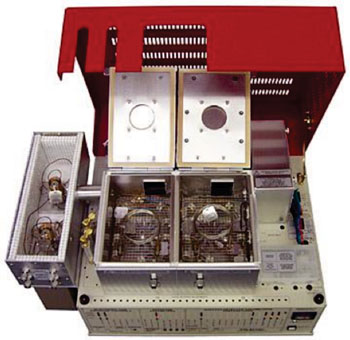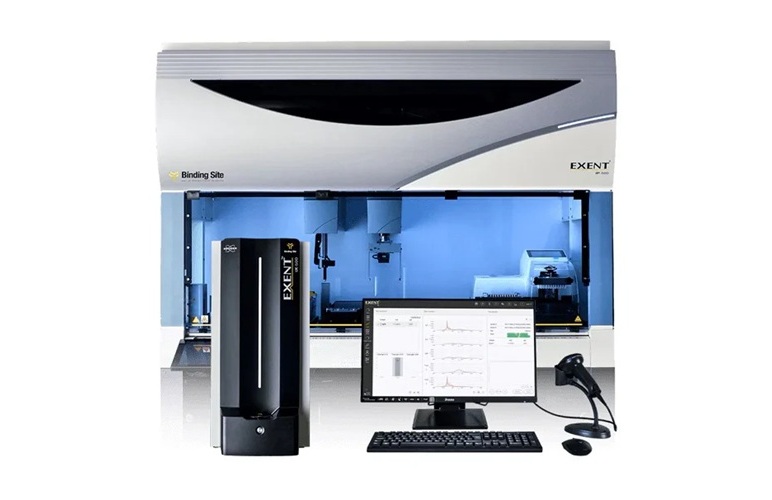Stool Samples Provide Marker for Bowel Disease
|
By LabMedica International staff writers Posted on 08 Apr 2014 |

Image: The SRI 8610C gas chromatograph (Photo courtesy of SRI Instruments).
A novel method for distinguishing different types of bowel disease using the stool samples of patients has been created which is an ideal noninvasive testing method for the diagnosis of gastro-intestinal diseases.
The method works by analyzing the chemical compounds emitted from the samples and could provide cheaper, quicker and more accurate diagnoses, at the point of care, for a group of diseases that have up until recently been very hard to differentiate.
Scientists at the University of the West of England (Bristol, UK) obtained 182 stool samples from patients with inflammatory bowel disease (IBD) and irritable bowel syndrome (IBS) between October 2010 and October 2011. IBS samples were obtained from patients with diarrhea predominant (IBS-D), constipation predominant (IBS-C), and the alternating between the two syndrome (IBS-A). IBD samples were obtained from patients with both ulcerative colitis (UC) and Crohn's disease (CD). Control samples were collected from healthy patients.
The test was based on the volatile organic compounds (VOCs) emitted from their stool samples, which act as a proxy for conditions in the gastrointestinal tract and provide a unique profile, or fingerprint, for the different bowel diseases. The investigators developed the method using an SRI 8610C gas chromatograph (SRI Instruments, Torrance, CA, USA) coupled to a metal oxide sensor system with pattern recognition software.
The results showed that patients with IBD could be distinguished from healthy controls with an accuracy of 79%. The method was able to distinguish IBD from IBS with an accuracy of 76%. Differentiating patients with IBS from healthy controls using VOCs appeared to be more difficult and could only be achieved with an accuracy of 54%. The reasons could be because IBS is a functional disorder as opposed to a structural disorder, so the changes in composition of VOCs in the stool samples would not be as great, producing a very similar pattern to healthy controls.
In conclusion, the authors stated that: “Our work has demonstrated that a low-cost device based on VOC analysis could be used to potentially diagnose, and differentiate, IBS and IBD at the point of care. We will continue to study fecal volatiles as a way of detecting IBS, IBD and other gastrointestinal conditions and continue to develop our techniques further. If we're able to produce results that exceed current commercial methods, then our technique could be added to the growing number of medical tests that use VOC analysis as a diagnostic tool.” The study was published on March 27, 2014, in the Journal of Breath Research.
Related Links:
University of the West of England
SRI Instruments
The method works by analyzing the chemical compounds emitted from the samples and could provide cheaper, quicker and more accurate diagnoses, at the point of care, for a group of diseases that have up until recently been very hard to differentiate.
Scientists at the University of the West of England (Bristol, UK) obtained 182 stool samples from patients with inflammatory bowel disease (IBD) and irritable bowel syndrome (IBS) between October 2010 and October 2011. IBS samples were obtained from patients with diarrhea predominant (IBS-D), constipation predominant (IBS-C), and the alternating between the two syndrome (IBS-A). IBD samples were obtained from patients with both ulcerative colitis (UC) and Crohn's disease (CD). Control samples were collected from healthy patients.
The test was based on the volatile organic compounds (VOCs) emitted from their stool samples, which act as a proxy for conditions in the gastrointestinal tract and provide a unique profile, or fingerprint, for the different bowel diseases. The investigators developed the method using an SRI 8610C gas chromatograph (SRI Instruments, Torrance, CA, USA) coupled to a metal oxide sensor system with pattern recognition software.
The results showed that patients with IBD could be distinguished from healthy controls with an accuracy of 79%. The method was able to distinguish IBD from IBS with an accuracy of 76%. Differentiating patients with IBS from healthy controls using VOCs appeared to be more difficult and could only be achieved with an accuracy of 54%. The reasons could be because IBS is a functional disorder as opposed to a structural disorder, so the changes in composition of VOCs in the stool samples would not be as great, producing a very similar pattern to healthy controls.
In conclusion, the authors stated that: “Our work has demonstrated that a low-cost device based on VOC analysis could be used to potentially diagnose, and differentiate, IBS and IBD at the point of care. We will continue to study fecal volatiles as a way of detecting IBS, IBD and other gastrointestinal conditions and continue to develop our techniques further. If we're able to produce results that exceed current commercial methods, then our technique could be added to the growing number of medical tests that use VOC analysis as a diagnostic tool.” The study was published on March 27, 2014, in the Journal of Breath Research.
Related Links:
University of the West of England
SRI Instruments
Latest Technology News
- AI Saliva Sensor Enables Early Detection of Head and Neck Cancer
- AI-Powered Biosensor Technology to Enable Breath Test for Lung Cancer Detection
- AI Model Achieves Breakthrough Accuracy in Ovarian Cancer Detection
- Portable Biosensor Diagnoses Psychiatric Disorders Using Saliva Samples
- Cell-Sorting Device Uses Electromagnetic Levitation to Precisely Direct Cell Movement

- Embedded GPU Platform Enables Rapid Blood Profiling for POC Diagnostics
- Viral Biosensor Test Simultaneously Detects Hepatitis and HIV
- Acoustofluidic Device to Transform Point-Of-Care sEV-Based Diagnostics
- AI Algorithm Assesses Progressive Decline in Kidney Function
Channels
Molecular Diagnostics
view channel
Blood Test to Help Low-Risk Gastric Cancer Patients Avoid Unnecessary Surgery
Accurately identifying lymph node metastasis in early-stage gastric cancer remains a major clinical challenge. CT imaging often misses up to half of lymph node–positive cases, leading clinicians to recommend... Read more
First-Of-Its-Kind Automated System Speeds Myeloma Diagnosis
More than 176,000 people are diagnosed with multiple myeloma worldwide each year, yet the current diagnostic pathway can be slow and uncertain, often relying on a highly subjective interpretation of test results.... Read moreHematology
view channel
Platelet Activity Blood Test in Middle Age Could Identify Early Alzheimer’s Risk
Early detection of Alzheimer’s disease remains one of the biggest unmet needs in neurology, particularly because the biological changes underlying the disorder begin decades before memory symptoms appear.... Read more
Microvesicles Measurement Could Detect Vascular Injury in Sickle Cell Disease Patients
Assessing disease severity in sickle cell disease (SCD) remains challenging, especially when trying to predict hemolysis, vascular injury, and risk of complications such as vaso-occlusive crises.... Read more
ADLM’s New Coagulation Testing Guidance to Improve Care for Patients on Blood Thinners
Direct oral anticoagulants (DOACs) are one of the most common types of blood thinners. Patients take them to prevent a host of complications that could arise from blood clotting, including stroke, deep... Read moreImmunology
view channel
Gene Signature Test Predicts Response to Key Breast Cancer Treatment
DK4/6 inhibitors paired with hormone therapy have become a cornerstone treatment for advanced HR+/HER2– breast cancer, slowing tumor growth by blocking key proteins that drive cell division.... Read more
Chip Captures Cancer Cells from Blood to Help Select Right Breast Cancer Treatment
Ductal carcinoma in situ (DCIS) accounts for about a quarter of all breast cancer cases and generally carries a good prognosis. This non-invasive form of the disease may or may not become life-threatening.... Read moreMicrobiology
view channel
Rapid Assay Identifies Bloodstream Infection Pathogens Directly from Patient Samples
Bloodstream infections in sepsis progress quickly and demand rapid, precise diagnosis. Current blood-culture methods often take one to five days to identify the pathogen, leaving clinicians to treat blindly... Read more
Blood-Based Molecular Signatures to Enable Rapid EPTB Diagnosis
Extrapulmonary tuberculosis (EPTB) remains difficult to diagnose and treat because it spreads beyond the lungs and lacks easily accessible biomarkers. Despite TB infecting 10 million people yearly, the... Read more
15-Minute Blood Test Diagnoses Life-Threatening Infections in Children
Distinguishing minor childhood illnesses from potentially life-threatening infections such as sepsis or meningitis remains a major challenge in emergency care. Traditional tests can take hours, leaving... Read more
High-Throughput Enteric Panels Detect Multiple GI Bacterial Infections from Single Stool Swab Sample
Gastrointestinal (GI) infections are among the most common causes of illness worldwide, leading to over 1.7 million deaths annually and placing a heavy burden on healthcare systems. Conventional diagnostic... Read morePathology
view channelAI Tool Outperforms Doctors in Spotting Blood Cell Abnormalities
Diagnosing blood disorders depends on recognizing subtle abnormalities in cell size, shape, and structure, yet this process is slow, subjective, and requires years of expert training. Even specialists... Read more
AI Tool Rapidly Analyzes Complex Cancer Images for Personalized Treatment
Complex digital biopsy images that typically take an expert pathologist up to 20 minutes to assess can now be analyzed in about one minute using a new artificial intelligence (AI) tool. The technology... Read moreTechnology
view channel
AI Saliva Sensor Enables Early Detection of Head and Neck Cancer
Early detection of head and neck cancer remains difficult because the disease produces few or no symptoms in its earliest stages, and lesions often lie deep within the head or neck, where biopsy or endoscopy... Read more
AI-Powered Biosensor Technology to Enable Breath Test for Lung Cancer Detection
Detecting lung cancer early remains one of the biggest challenges in oncology, largely because current tools are invasive, expensive, or unable to identify the disease in its earliest phases.... Read moreIndustry
view channel
Abbott Acquires Cancer-Screening Company Exact Sciences
Abbott (Abbott Park, IL, USA) has entered into a definitive agreement to acquire Exact Sciences (Madison, WI, USA), enabling it to enter and lead in fast-growing cancer diagnostics segments.... Read more






















